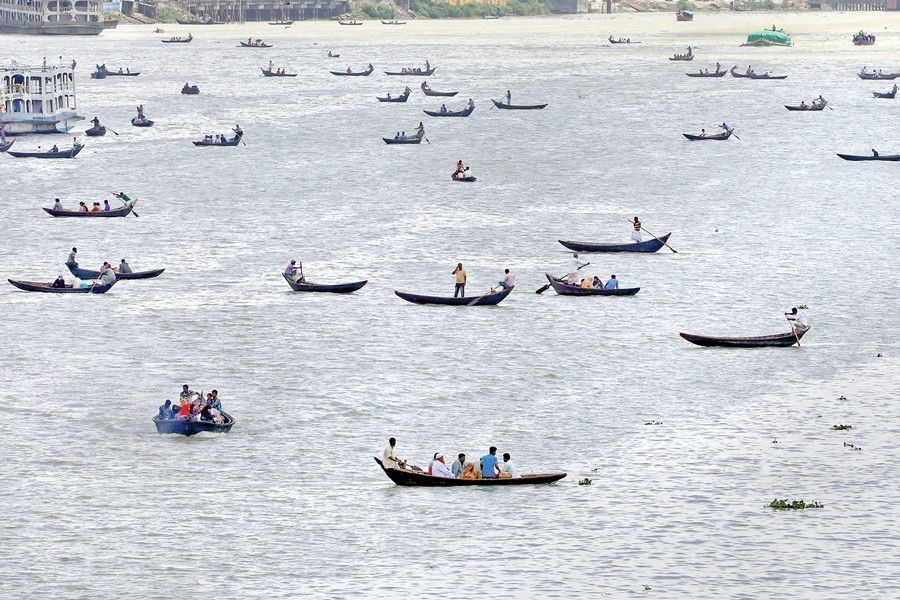Following the shifting of the environment and river-water polluting tanneries from Dhaka's Hazaribagh area to Savar, the western part of the Buriganga has been in a healthy state for the last four years.Though feared to be short-lived, it has provided a relief of sorts to the people residing on the river's banks. However, as the dingy small factories still operate there, releasing wastes and effluents, fear of the pollutions' return stalks the local people. Meanwhile, two months of monsoon create a salubrious ambience in the vast area. Nowadays, it adds to the tolerably pollution-free state of the river in its western segment. However, all this is a part of the 18 km (11 miles) stretch of the Buriganga. Amid the monsoon rains, water in rising volumes from the adjoining rivers flows into the Buriganga, completing a freshening lookof the river, on which Dhaka stands.
Like every year, the highly polluted Buriganga River on the southern flank of the capital Dhaka is set to wear this attractive look in less than a month. With the advent of the 2-month Bangla monsoon --- Asharh and Sraban, the whole river's water turns temptingly clean. In those days the water remains free of filth for two months. The changed look of the river is a scene worth watching to heart's content; the people being those using the river for long. Along with the river's main channel flowing out of the Dhaleshwari; the smaller Turag, a Shitalakhya branch and the Balu also start getting transformed during the monsoon. Normally, the dumping of solid and other wastes, including medical, and those of chemical origin --- in particular the factory effluents, wouldn't see any respite during this time. This situation prevailed as a scourge for the Old Dhaka before the tanneries' shifting.
During monsoon, the factor that contributes to the radical change in the Buriganga's look and its water quality is the increased level of water caused by rain. Many southern Old Dhaka residents wish the pollution and stench-free water of the river stayed for the whole year. It's because hydrologists and river experts have long termed the Buriganga water beyond human use. Moreover, the water has been declared unfit for survival of any living organism. Except the season of the Asharh-Srabanmonsoon and a couple of months following it, lots of hygiene-conscious people remain afraid of even washing their feet in the river. During the lean period, the river's water turns greenish blue. At places, its water is seen filled with all conceivable pollutants including even carcasses of animals. In consideration of the process of pollution continuing at this scale, the name of Buriganga finds place alongside the highly polluted rivers in South Asia.
Hadn't the Buriganga waters been blessed and washed away by the country's yearly monsoons, the river would have met the destiny of the now-moribund Balu or the winter-time Turag. None can say with affirmation that the pollution-plagued Buriganga is not hurtling towards that plight. Even the spectre of the river, a living witness to Dhaka city's growth as a trade and commercial centre for nearly three hundred years, ending up being an obscure shrunken flow cannot be dismissed. Perhaps few rivers in the world have met such a miserable fate after making innumerable contributions to the rise of a historic capital. Unlike many of its counterparts, Dhaka has never been invaded or overrun by any powerful armada.Its trade and business activities had continued unhindered thanks to its safe location beside the Buriganga, which remains navigable round the year.
It is mainly in the late 20th century, when wise and pragmatic people began foreseeing the river's benighted future in the making. The ominous developments emerged in the form of blatant encroachments on the river, along with the mushrooming of makeshift factories on its two banks. It took just a decade for the river's water to turn toxic and unfit for human consumption. Finally, it was declared unsuitable for thesurvival of all living organisms. Fishes and other similar water creatures had long deserted the river due to its adverse underwater atmosphere.
Few had the portents even in their terrible fits of nightmares about this turn of the Buriganga. In the 21st century, the river functions mainly as a water-route for passenger and cargo vessels. This is the premier role a nationally important river is expected to assume. But what upsets many is its process of slow decaying. Continued pollution has changed the normal water quality of the river due to its flow being mixed with dozens of toxic substances and organic wastes.In short, the Buriganga is in its death throes. The season of monsoon comes as a relief. It re-enacts the earlier form and features of the river --- in particular both its sprightly and serene nature. During the last four centuries, the river saw continued trading activities conducted by the merchants belonging to the Mughal, British colonial and Pakistani neo-colonial eras. And as dictated by history, the riverside capital of Dhaka emerged as an urban centre. Dhaka eventually earned the fame of a sprawling city having railway and waterway routes connecting the whole Bengal.
The Buriganga has long been on the path to decadence. But a dying river cannot remain beyond rejuvenation. In the case of Buriganga, the task should start with unremitting drives of demolishing illegal factories and business establishments, markets etc. These sources of water pollution ought to be evicted once and for all to bring back the river's buoyant past. The Dhaka residents get a fleeting look of this vibrancy during the 2-month monsoon.


